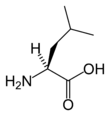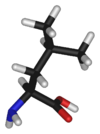Leucine
 
| |
Leucine | |
| Systematic (IUPAC) name | |
| (S)-2-amino-4-methyl-pentanoic acid | |
| Identifiers | |
| CAS number | 61-90-5 |
| PubChem | 6106 |
| Chemical data | |
| Formula | C6H13NO2 |
| Mol. weight | 131.18 |
| SMILES | CC(C)C[C@H](N)C(O)=O |
| Complete data | |
Leucine is an α-amino acid that is found in most proteins and is essential in the human diet. It is similar to isoleucine and valine in being a branched-chain amino acid and it is an isomer of isoleucine. (Isomers are molecules with the same chemical formula and often with the same kinds of chemical bonds between atoms, but in which the atoms are arranged differently.)
In humans, the L-isomer of leucine is one of the 20 standard amino acids common in animal proteins and required for normal functioning in humans. Leucine is also classified as an "essential amino acid" since it cannot be synthesized by the human body from other compounds through chemical reactions and thus has to be taken in with the diet.
Also like isoleucine and valine, the lack of a particular enzyme in humans can result in the buildup of leucine in the blood and urine, a disorder known as maple syrup urine disease (MSUD). While the importance of a disciplined diet is important to all individuals in order to obtain the essential amino acids and other nutrients, this reality is particularly impressed upon those suffering with MSUD. Such individuals need to obtain the necessary minimal levels of isoleucine without consuming too much that would result in the symptoms.
The precision and complex coordination in the universe is revealed in leucine's role in proteins. Leucine's structure, like that of isoleucine, makes it important for the correct folding of proteins, whose functionality is dependent upon the ability to fold into a precise three-dimensional shape. Harmony also is seen among living organisms in the fact that plants can synthesize leucine, which can then be obtained by animals.
Leucine's three letter code is Leu, its one letter code is L, its codons are UUA, UUG, CUU, and CUC, and its systematic name is 2-amino-4-methyl-pentanoic acid (IUPAC-IUB 1983).
Structure
In biochemistry, the term amino acid is frequently used to refer specifically to alpha amino acids—those amino acids in which the amino and carboxylate groups are attached to the same carbon, the so-called α–carbon (alpha carbon). The general structure of these alpha amino acids is:
R | H2N-C-COOH | H
where R represents a side chain specific to each amino acid.
Most amino acids occur in two possible optical isomers, called D and L. The L amino acids represent the vast majority of amino acids found in proteins. They are called proteinogenic amino acids. As the name "proteinogenic" (literally, protein building) suggests, these amino acid are encoded by the standard genetic code and participate in the process of protein synthesis. In leucine, only the L-stereoisomer is involved in synthesis of mammalian proteins.
Leucine's chemical formula is (CH3)2CH-CH2-CH(NH2)-COOH (IUPAC-IUB 1983). As isomers, leucine and isoleucine share the same general formula C6H13NO2.
Leucine, like both isoleucine and valine, has large aliphatic hydrophobic side chains, making it a hydrophobic amino acid. Its molecules are rigid, and its mutual hydrophobic interactions are important for the correct folding of proteins, as these chains tend to be located inside of the protein molecule.
Dietary aspects
As an essential amino acid, leucine is not synthesized in animals, hence it must be ingested, usually as a component of proteins.
Major food sources of leucine include whole grains, milk products, eggs (~1 g/100g), pork, beef, chicken, peanuts, pulses (such as soybeans at ~3 g/100g, chick peas, and lentils) and leaf vegetables.
Biosynthesis
Leucine is synthesized in plants and microorganisms via several steps starting from pyruvic acid. The initial part of the pathway also leads to valine. The intermediate α-ketovalerate is converted to α-isopropylmalate and then β-isopropylmalate, which is dehydrogenated to α-ketoisocaproate, which in the final step undergoes reductive amination. Enzymes involved in a typical biosynthesis include (Lehninger 2000):
- acetolactate synthase
- acetohydroxy acid isomeroreductase
- dihydroxyacid dehydratase
- α-isopropylmalate synthase
- α-isopropylmalate isomerase
- leucine aminotransferase
Maple syrup urine disease
Maple syrup urine disease (MSUD) is an autosomal recessive metabolic disorder of amino acid metabolism. It is also called branched chain ketoaciduria.
This amino acid acidopathy is due to a deficiency of the metabolic enzyme branched chain α-keto acid dehydrogenase (BCKDH) leading to a buildup of the branched-chain amino acids leucine, isoleucine, and valine in the blood and urine.
MSUD is characterized by an infant with sweet-smelling urine with an odor similar to that of maple syrup. Infants with this disease seem healthy at birth but if left untreated suffer severe brain damage and eventually die. Because of a genetic bottleneck effect, MSUD has a much higher prevalence in children of Amish and Mennonite descent.
From early infancy, the condition is characterized by poor feeding, vomiting, lack of energy (lethargy), seizures, and mental health issues. The urine of affected infants has a distinctive sweet odor, much like burned caramel, that gives the condition its name.
Treatment of the MSUD, like diabetes, requires careful monitoring of blood chemistry and involves both special diet and frequent testing. A diet with minimal levels of the amino acids leucine, isoleucine, and valine must be maintained in order to prevent neurological damage. Usually patients or parents of patients are assisted by a physician or dietician. This diet must be adhered to strictly and permanently. However, with proper treatment those afflicted are able to live healthy, normal lives and not suffer the severe neurological damage that characterizes the untreated disease.
ReferencesISBN links support NWE through referral fees
- Doolittle, R. F. 1989. Redundancies in protein sequences. In G. D. Fasman, ed., Prediction of Protein Structures and the Principles of Protein Conformation. New York: Plenum Press. ISBN 0306431319.
- International Union of Pure and Applied Chemistry and International Union of Biochemistry and Molecular Biology (IUPAC-IUB) Joint Commission on Biochemical Nomenclature. 1983. Nomenclature and symbolism for amino acids and peptides: Recommendations on organic & biochemical nomenclature, symbols & terminology IUPAC-IUB. Retrieved June 28, 2018.
- Lehninger, A. L., D. L. Nelson, and M. M. Cox. 2000. Lehninger Principles of Biochemistry, 3rd ed. New York: Worth Publishing. ISBN 1572591536.
External links
All links retrieved March 11, 2025.
| Major families of biochemicals | ||
| Peptides | Amino acids | Nucleic acids | Carbohydrates | Nucleotide sugars | Lipids | Terpenes | Carotenoids | Tetrapyrroles | Enzyme cofactors | Steroids | Flavonoids | Alkaloids | Polyketides | Glycosides | ||
| Analogues of nucleic acids: | The 20 Common Amino Acids | Analogues of nucleic acids: |
| Alanine (dp) | Arginine (dp) | Asparagine (dp) | Aspartic acid (dp) | Cysteine (dp) | Glutamic acid (dp) | Glutamine (dp) | Glycine (dp) | Histidine (dp) | Isoleucine (dp) | Leucine (dp) | Lysine (dp) | Methionine (dp) | Phenylalanine (dp) | Proline (dp) | Serine (dp) | Threonine (dp) | Tryptophan (dp) | Tyrosine (dp) | Valine (dp) | ||
Credits
New World Encyclopedia writers and editors rewrote and completed the Wikipedia article in accordance with New World Encyclopedia standards. This article abides by terms of the Creative Commons CC-by-sa 3.0 License (CC-by-sa), which may be used and disseminated with proper attribution. Credit is due under the terms of this license that can reference both the New World Encyclopedia contributors and the selfless volunteer contributors of the Wikimedia Foundation. To cite this article click here for a list of acceptable citing formats.The history of earlier contributions by wikipedians is accessible to researchers here:
The history of this article since it was imported to New World Encyclopedia:
Note: Some restrictions may apply to use of individual images which are separately licensed.